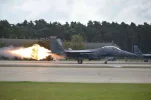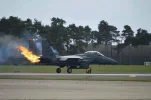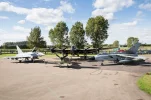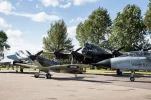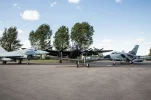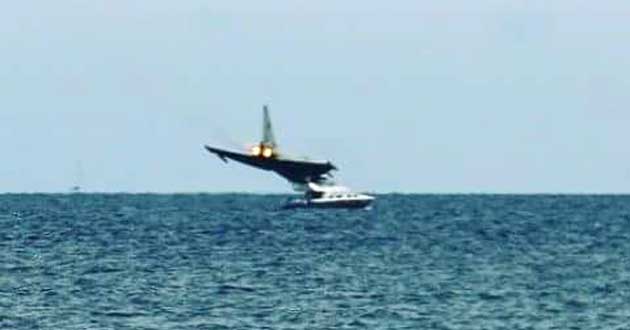En tiedä numeroiden paikkansapitävyyttä, mutta ihan kielenkiintoinen kuva WW2-aikaisten hävittäjien toimintasäteestä.
Ihan pitäisi olla oikeansuuntaisia. Tuo oli yksi ratkaisevia tekijöitä sodan kääntymisessä liittoutuneille. Tuon ja ilmasotatrategian muutoksen myötä Luftwaffe tuhottiin ilmassa, kentille ja tuotantolaitoksissa.
https://en.wikipedia.org/wiki/Operational_history_of_the_Luftwaffe_(1939–45)
The turn of the tide
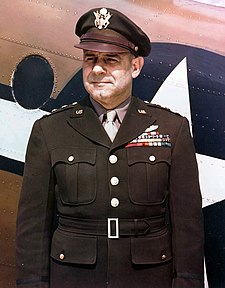
Maj. Gen. Jimmy Doolittle's change in American fighter tactics doomed the Luftwaffe fighter force during 1944.
Until the development of Allied long-range fighters the Luftwaffe remained capable of inflicting serious losses by the day fighter and night fighter units (
Nachtgeschwader), as well as the anti-aircraft guns under its command.
The turn in the Luftwaffe's fortunes came during
Big Week in which the U.S. Eighth Air Force flying from bases in Britain, and
Fifteenth Air Force flying from bases in Southern Italy, carried out raids against German aviation industry throughout Europe. The new commander of the US Eighth Air Force, Maj. Gen.
Jimmy Doolittle's major influence on the European air war occurred early in 1944 when he changed the policy requiring escorting American fighters to remain with the bombers at all times. With his permission, initially performed with
P-38s and
P-47s with both previous types being steadily replaced with the long-ranged
P-51s as the spring of 1944 wore on, American fighter pilots on bomber defense missions would primarily be flying far ahead of the bombers'
combat box formations in
air supremacy mode, literally "clearing the skies" of any
Luftwaffe fighter opposition heading towards the target.
This strategy fatally disabled the twin-engined
Zerstörergeschwader heavy fighter wings and their replacement, single-engined
Sturmgruppen of
heavily armed Fw 190As, clearing each force of
bomber destroyers in their turn from Germany's skies throughout most of 1944. As part of this game-changing strategy, especially after the bombers had hit their targets, the USAAF's fighters were then free to strafe German airfields and transport while returning to base, contributing significantly to the achievement of air superiority by Allied air forces over Europe. During the Big Week bomber campaign of late February 1944 which started to introduce the new fighter tactics, American medium and heavy bombers together dropped roughly 10,000 tons of bombs and seriously disrupted German fighter production. During Big Week, the Eighth Air Force lost 97 B-17s. Coupled with
B-24 losses the figure totaled 137 initially and 20 more scrapped due to damage.
[91] The Fifteenth Air Force lost 90 aircraft and American fighter losses stood at 28. The Luftwaffe losses were high amongst their twin-engined
Zerstörer units which suffered heavy losses and decimated the Bf 110 and Me 410
Gruppen.
[92] More worrying for the Jagdwaffe was the loss of 17 per-cent of its pilots; nearly 100 were killed.
[93] The tide had turned, and air superiority had passed to the Western Allies.
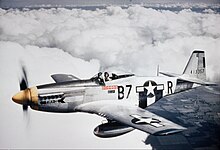
P-51D 374th Fighter Squadron. This is an early D-model, without the fin strake; 75 gallon (284 litre) drop tanks are on the wing racks.
When long-range fighter support became widely available by May 1944, the
Luftwaffe's defensive effort was severely damaged. The
P-51D Mustangs and
P-47 Thunderbolts with extended range were now able to escort the bombers to and from the target. The Luftwaffe now did not have opportunity to attack the unprotected fleets. The resulting air battles diminished the strength of the
Jagdwaffe.
U.S. and RAF fighters undertook many fighter sweeps, and the boundaries of the front line steadily moved eastward. They engaged many Luftwaffe training aircraft, and the helpless
Jagdflieger of tomorrow were shot down in droves. Pilot training had become shorter in order to fill the front line
Gruppen, which often had more aircraft than pilots. German aircraft production reached its peak in August 1944, finally equaling the Soviet and American output, but the production came too late to alter the outcome of the air war. The Luftwaffe had plenty of aircraft but a critical shortage of experienced fighter pilots.
[94]



